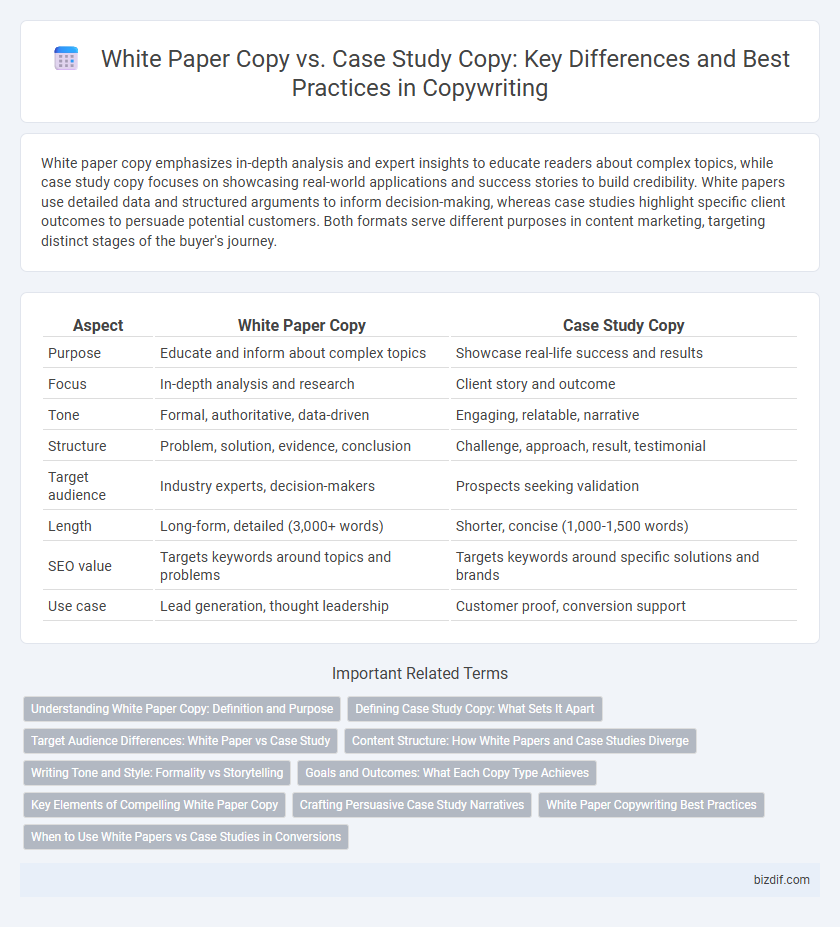White paper copy emphasizes in-depth analysis and expert insights to educate readers about complex topics, while case study copy focuses on showcasing real-world applications and success stories to build credibility. White papers use detailed data and structured arguments to inform decision-making, whereas case studies highlight specific client outcomes to persuade potential customers. Both formats serve different purposes in content marketing, targeting distinct stages of the buyer's journey.
Table of Comparison
| Aspect | White Paper Copy | Case Study Copy |
|---|---|---|
| Purpose | Educate and inform about complex topics | Showcase real-life success and results |
| Focus | In-depth analysis and research | Client story and outcome |
| Tone | Formal, authoritative, data-driven | Engaging, relatable, narrative |
| Structure | Problem, solution, evidence, conclusion | Challenge, approach, result, testimonial |
| Target audience | Industry experts, decision-makers | Prospects seeking validation |
| Length | Long-form, detailed (3,000+ words) | Shorter, concise (1,000-1,500 words) |
| SEO value | Targets keywords around topics and problems | Targets keywords around specific solutions and brands |
| Use case | Lead generation, thought leadership | Customer proof, conversion support |
Understanding White Paper Copy: Definition and Purpose
White paper copy serves as an authoritative, in-depth document designed to educate readers about complex issues, products, or services, establishing trust and credibility in a specific industry. It aims to provide detailed research, data-driven insights, and expert analysis to help decision-makers understand challenges and solutions clearly. Unlike case study copy, which focuses on real-world outcomes and success stories, white paper copy emphasizes comprehensive information and thought leadership.
Defining Case Study Copy: What Sets It Apart
Case study copy focuses on real-world examples to illustrate the effectiveness of a product or service, highlighting specific client challenges, solutions, and measurable results. It differs from white paper copy by emphasizing storytelling and emotional engagement rather than in-depth technical analysis or industry research. The narrative-driven approach in case studies builds credibility and trust by showcasing tangible outcomes and client success.
Target Audience Differences: White Paper vs Case Study
White paper copy targets industry professionals and decision-makers seeking in-depth analysis and data-driven insights to understand complex issues or trends. Case study copy appeals to potential customers or clients looking for practical examples and success stories that demonstrate product effectiveness and real-world results. White papers emphasize technical details and thought leadership, while case studies focus on relatable experiences and measurable outcomes.
Content Structure: How White Papers and Case Studies Diverge
White papers follow a structured format emphasizing problem definition, in-depth analysis, and expert solutions supported by data and research. Case studies prioritize storytelling, showcasing real-world customer experiences with a clear challenge, implemented solution, and measurable outcomes. This divergent content structure aligns white papers with thought leadership and case studies with practical proof of success.
Writing Tone and Style: Formality vs Storytelling
White paper copy emphasizes a formal and authoritative writing tone, using precise, data-driven language to establish credibility and inform industry professionals. Case study copy adopts a storytelling style that highlights real-world applications and customer experiences, engaging readers emotionally while demonstrating practical benefits. This contrast in writing tone and style shapes how each format communicates value--white papers prioritize factual analysis, whereas case studies focus on relatable narratives.
Goals and Outcomes: What Each Copy Type Achieves
White paper copy aims to educate and inform decision-makers by presenting detailed research, data, and expert analysis to establish authority and drive strategic action. Case study copy focuses on showcasing real-world success stories and measurable results to build trust, demonstrate effectiveness, and influence purchase decisions. Each copy type targets different stages of the buyer journey, with white papers pushing for awareness and credibility, while case studies emphasize proof of value and conversion.
Key Elements of Compelling White Paper Copy
Compelling white paper copy emphasizes in-depth research, authoritative data, and clear problem-solving insights that build trust and establish thought leadership. It integrates well-structured sections with detailed analysis, expert quotes, and actionable takeaways to educate and persuade a targeted audience. Unlike case study copy, it prioritizes comprehensive context and objective evidence to present complex information in a credible, engaging manner.
Crafting Persuasive Case Study Narratives
Case study copy excels in crafting persuasive narratives by showcasing real-life customer experiences and measurable outcomes, making abstract benefits tangible and relatable. White paper copy tends to focus on detailed data analysis and in-depth industry insights, but lacks the emotional appeal that drives decision-making in case studies. Highlighting specific challenges overcome and quantifiable results achieved enhances the credibility and impact of case study copy in converting prospects.
White Paper Copywriting Best Practices
White paper copywriting best practices emphasize clear, data-driven content that educates and informs a professional audience about complex issues while positioning a solution as authoritative. Incorporating well-researched statistics, expert insights, and a logical structure enhances credibility and reader trust. Effective white paper copy leverages precise language and detailed analysis to establish thought leadership and support decision-making processes.
When to Use White Papers vs Case Studies in Conversions
White papers excel at educating prospects with in-depth analysis, making them ideal for high-consideration sales cycles where trust and authority drive conversions. Case studies perform best when showcasing real-world success stories to validate your product or service, effectively influencing decision-makers during the evaluation phase. Use white papers to build foundational knowledge and case studies to reinforce credibility and close deals.
White Paper Copy vs Case Study Copy Infographic

 bizdif.com
bizdif.com